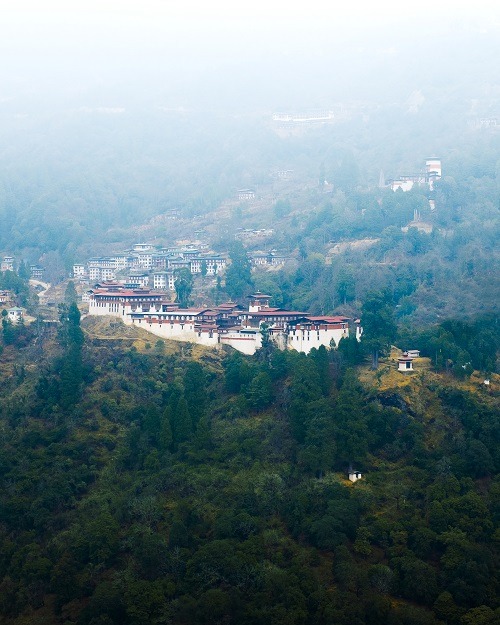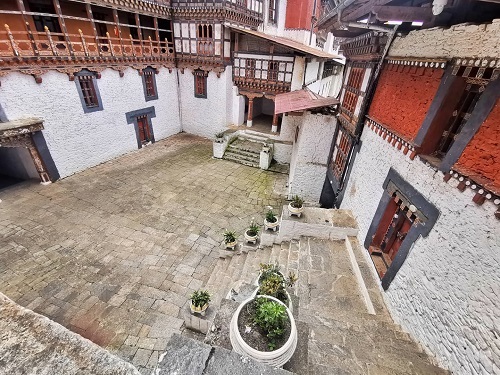
Trongsa Dzong literally means ‘the fortress on the tip of a Dungkhar (conch) of the never-changing country of Druk and the everlasting Dharma.’ Trongsa Dzong was built in 1647 during the time of Trongsa Penlop Chogyal Minjur Tenpa. It’s strategically located overlooking the Mangde Chhu (river).
Trongsa Dzong is not just one of the most iconic landmarks in Bhutan but also a symbol of the country's rich history and cultural heritage. Located in central Bhutan, this magnificent fortress monastery holds a deep connection to the royal family and Bhutanese governance. Below are five fascinating facts about Trongsa Dzong that make it a must-visit destination.
1. The Largest Fortress In Bhutan
Trongsa Dzong was the seat of power over central and eastern bhutan. This massive dzong is the largest fortress in Bhutan. You can see Trongsa Dzong long before you actually reach Trongsa. The intricacy of its buildings is clearly visible from the town. The sheer size of the dzong makes it an awe-inspiring sight, and its strategic location allowed it to play a key role in controlling the east-west trade routes in earlier times.
Trongsa Dzong is undoubtedly one of the most impressive dzongs in Bhutan. It showcases the magnificence of Bhutanese craftsmanship and traditional Bhutanese architecture. Narrow stone stairs, alleys, and corridors connect the buildings.

2. The Headquarters Of The Government Of Trongsa District
Trongsa Dzong is an important administrative building that serves as the headquarters of the government of Trongsa district. Trongsa is a strategic central location to control Bhutan, and for centuries, it was the seat of the Wangchuck dynasty. Thus, Trongsa Dzong is closely connected to the royal family. It was in this dzong that the first two Bhutanese kings ruled the country. Tradition also dictates that the crown prince serves as Trongsa penlops (governors) before acceding to the throne.
3. Trongsa Dzong Has Numerous Meditation Centers
Trongsa Dzong was founded by Yingzin Ngagi Wangchuk, a Ngawang Chogyal descendant and a revered Kuenkhen Pema Karpo follower. In 1541, he meditated at the village of Yueli in Trongsa, a few kilometers from the present dzong. During the meditation, he saw a lighted butter lamp below the ridge at the present goenkhang, which houses the guardian deities, Palden Lhamo (Mahakali) and Yeshey Goenpo (Mahakala).
Considering the place to be sacred, he built mediation quarters. There was once during his meditation in the new quarter, the deity Palden Lhamo appeared and prophesied that this place would play an important role in spreading the teachings of Buddha.
After that incident, Yingzin Ngagi Wangchuk constructed a small temple named Mondrupley. Over the years, his disciples built many smaller meditation centers or chapels, shrines, and temples, each dedicated to various deities, historical figures, and Buddhist teachings. Soon, it began to resemble a small village. The people of Yueli named this new village Trong-sar (new village).
4. Reconstructed In 1927

Although the origins of Trongsa Dzong date back to the 16th century, it underwent a major reconstruction in 1927 due to an earthquake in 1987. This restoration work was ordered by then penlop of Trongsa, Jigme Namgyal, father of Bhutan’s first king, to preserve the structural integrity of the dzong while maintaining its historical significance. Today, the restored fortress stands as a tribute to Bhutan's efforts to preserve its heritage.
There is a watchtower, 25 temples dedicated to Tantric deities, a museum, and a printing shop that produce religious texts within Trongsa Dzong. Most of the decoration was designed during the rule of the first king, Ugyen Wangchuck. During winter, the Trongsa rabdey (district monk body) also migrate to Trongsa Dzong from Bumthang Dzong.
5. Spring And Autumn Are The Best Times To Visit Trongsa Dzong
The best time to visit Trongsa Dzong is during the spring and autumn months, from March to May and September to November.
These periods offer pleasant weather, making it easier to explore the fortress and enjoy the surrounding landscape. Winter can be cold, while the summer monsoon season might affect travel plans due to heavy rains.
6. Festivals And Cultural Events At Trongsa Dzong
Trongsa Dzong comes alive during the annual Trongsa Tsechu, a vibrant festival held in December or January. The tsechu features traditional mask dances, religious rituals, and other cultural performances that offer visitors an authentic glimpse into Bhutanese traditions. This event is a religious occasion and a social gathering for locals and tourists alike.
The five-day Trongsa tshechu is held in the northern courtyard in December or January. It culminates in the unveiling of a thongdrol (a giant thangka - a painted or embroidered religious scroll).
Conclusion About Interesting Facts About Trongsa Dzong
Trongsa Dzong is more than just a historical structure; it is a living testament to Bhutan's cultural and political evolution. Whether you're drawn to its architectural grandeur, its role in the district's governance, or the vibrant festivals, Trongsa Dzong remains a must-visit for anyone looking to explore the heart of Bhutanese history.
For those eager to experience the rich heritage of this iconic fortress, Druk Asia, a trusted Bhutan travel agency, offers expertly guided tours that provide a deep dive into its significance. Contact us to start planning your journey to Trongsa Dzong with Druk Asia today!
Frequently Asked Questions About Trongsa Dzong
How Old Is Trongsa Dzong?
Trongsa Dzong was originally built in the 16th century, with major reconstruction completed in 1927.
How Do I Get To Trongsa Dzong?
Trongsa Dzong is located in central Bhutan. It can be reached by road from Thimphu or Paro, though the journey may take several hours due to the mountainous terrain.
Are Guided Tours Available At Trongsa Dzong?
Yes, visitors can explore Trongsa Dzong through guided tours, where they can learn more about its history, architecture, and significance in Bhutanese culture.
Is There An Entry Fee For Visiting Trongsa Dzong?
Entry to Trongsa Dzong is generally free, but donations are appreciated to help with the preservation of the site.
Can I Visit Trongsa Dzong During The Tsechu Festival?
Yes, visiting during the Trongsa Tsechu festival is highly recommended to witness the cultural vibrancy and traditional performances at the dzong.